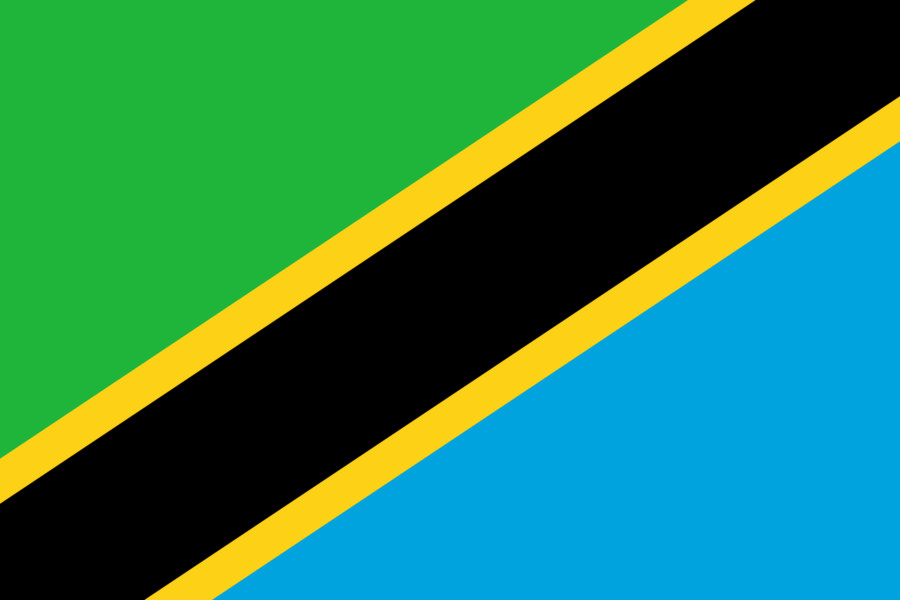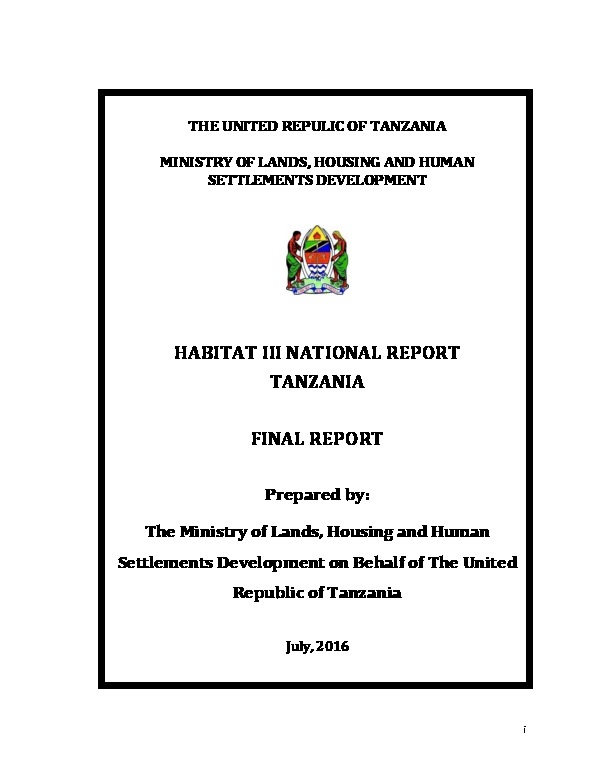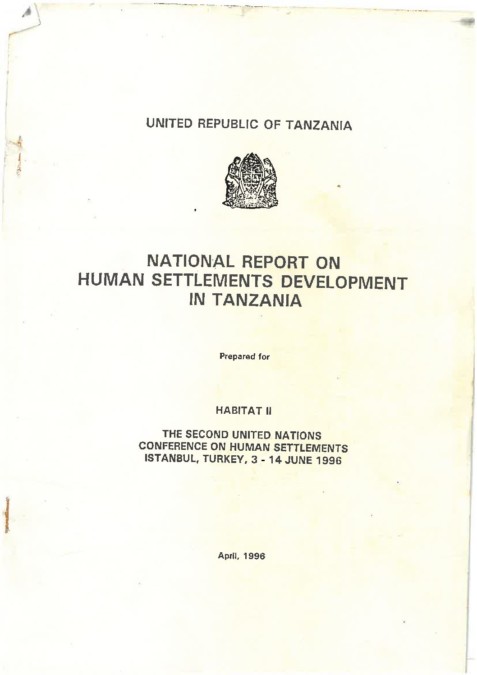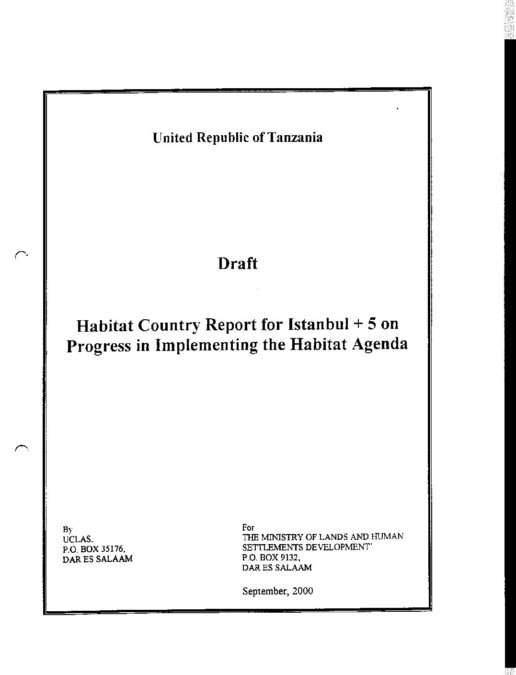
United Republic of Tanzania
Urban indicators:
| Value | Year | ||
| Surface area (sq km) | 947303 | 2014 | Including Zanzibar. |
| Population (proj., 000) | 55156 | 2016 | Including Zanzibar. |
| Pop. density (per sq km) | 62.3 | 2016 | Including Zanzibar. |
| Capital city | Dodoma | 2015 | |
| Capital city pop. (000) | 228 | 2015 | 2014. |
| Population growth rate (average annual %) | 3.2 | 2010-2015 | |
| Urban population growth rate (average annual %) | 5.4 | 2010-2015 | Including Zanzibar. |
| CO2 emission estimates (000 tons/tons per capita) | 10752/0.2 | 2013 | |
| Population using improved drinking water sources (urban/rural, %) | 77.2/45.6 | 2015 | |
| Population using improved sanitation facilities (urban/rural, %) | 31.3/8.3 | 2015 |
| 1995 | 2005 | 2014/2015 | |
| Urban population ('000) | 6,152 | 9,646 | 16,528 |
| Level of urbanization (%) | 20.5 | 24.8 | 31.6 |
| Proportion of urban population living in slum areas (%) | 73.7 | 66.4 | 50.7 |
| Urban Slum Population ('000) | 4,539 | 6,271 | 7,952 |
National Report:
National Report Executive Summary:
Managing rapid urbanization
Tanzania is committed to a people-centred development of human settlements, broadly classified into urban settlements, scattered agricultural villages and sparsely populated pastoral villages (URT 2013). Prime Minister’s Office, Regional Administration and Local Government (PMORALG) classify urban settlements into 5 cities, 18 municipalities, 4 towns and more than 300 small towns. Two challenges have been observed with respect to classification and designation of urban settlements in Tanzania: First is the presence of many rural trading centres not yet designated as urban settlements that are growing rapidly but in a haphazard manner, which are likely to develop into informal cities of tomorrow. Second is the lack of common criteria among government organs to designate and classify urban and rural settlements. A research study found that the Ministry of Lands, Housing and Human Settlements Development (MLHHSD) and the National Bureau of Statistics also designate and classify urban settlements each using different criteria (Muzzini E. and Lindeboom W. 2008).
Urbanisation in Tanzania is relatively low at 29.1% in 2012, up from 5.7% in 1967. The growth rate is about 5.2% per annum (URT 2006). Urban population is growing rapidly, and Tanzania cities are among the highly populated cities in Africa (URT 2013). Tanzania’s urban population is expected to reach 50% of the total national by 2030. This growth, which is largely fuelled by high rates of rural-urban migration, occurs in the form of densification of the major cities, lateral expansion of informal settlements and growth of rural trading centres. A survey conducted in 2015 reveals that 61.4% of the urban dwellers migrated from rural areas against 38.6% who have borne in urban areas.
The Local Government (District Authorities) Act and Local Government (Urban Authorities) Act of 1982 assign responsibilities for providing basic public services, maintaining peace, and order, managing and regulating land development to local government authorities (LGAs). Urban authorities have legal powers to prepare general and detailed urban plans, allocate building land and enforce development control measures. Rapid urban population growth stretches beyond limits, the ability of urban authorities that are poorly funded, to meet the ever-growing needs for planned and serviced land. The result is evident in the chaotic, sprawling urban growth patterns revealed for today, that make it costly to build and maintain infrastructure, raise the costs of travel and create traffic congestion.
Tanzania adopted the Urban Environmental Management Planning approach, implemented the Sustainable Cities and Urban Safety Programmes, which had a great impact on urban planning and management in the country. The government introduced a new Human Settlements Development Policy in 2000 and enacted a new Urban Planning Act in 2007 that advocates compact development. In collaboration with urban authorities and other stakeholders, the government has implemented several urban infrastructure and settlement upgrading projects aimed at improving urban transportation, access to water and sanitation services, particularly in the informal settlements, which accommodate about 62.5% of Tanzania’s urban population. A new urban management policy that will streamline roles of LGAs in managing sustainable urban development is under preparation and the government is also decongesting land management and urban planning responsibilities from the Ministry of Lands, Housing and Human Settlements Development by establishing eight zonal offices to deal with urban planning and approval processes.
Statistics:
Urban housing indicators
People living in slums (%)
Urban population with access to adequate housing (%)
Basic services and infrastructure
Urban population with access to safe drinking water (%)
Urban population with access to adequate sanitation (%)
Urban population with access to regular waste collection (%)
Urban population with access to public transport (%)
Level of effective decentralization
Share of local authorities’ expenditure financed from local revenue (%)
Indicators for urban policies, legislation and economy
Local authorities having implemented urban policies supportive of local economic development and creation of decent jobs and livelihoods (%)
Local authorities having adopted or implemented urban safety and security policies /strategies (%)
Local authorities having implemented plans and designs that are inclusive and respond to urban population growth adequately (%)
Share of national gross domestic product (GDP) that is produced in urban areas
Statements by United Republic of Tanzania:
-
Habitat III Plenaries
Statements by other countries on behalf of African Group and G77 and China:
-
Habitat III Plenaries
-
Intersessionals: Informal Intergovernmental Meetings (May 2016)
- Statement - 18 May (by Thailand) - English Made by Thailand on Behalf of G77 and China
- Statement – 18 May (by Nigeria, 1) - English Made by Nigeria on Behalf of African Group
- Statement - 18 May (by Jamaica) - English Made by Jamaica on Behalf of G77 and China
- Statement – 18 May (by Nigeria, 2) - English Made by Nigeria on Behalf of African Group
- Statement - 19 May (by Jamaica) - English Made by Jamaica on Behalf of G77 and China
- Statement – 19 May (by Nigeria, 1) - English Made by Nigeria on Behalf of African Group
- Statement - 19 May (by Kenya) - English Made by Kenya on Behalf of G77 and China
- Statement – 19 May (by Nigeria, 2) - English Made by Nigeria on Behalf of African Group
- Statement - 20 May (by Jamaica) - English Made by Jamaica on Behalf of G77 and China
- Statement – 20 May (by Nigeria, 1) - English Made by Nigeria on Behalf of African Group
- Statement - 20 May (by Thailand) - English Made by Thailand on Behalf of G77 and China
- Statement – 20 May (by Nigeria, 2) - English Made by Nigeria on Behalf of African Group



